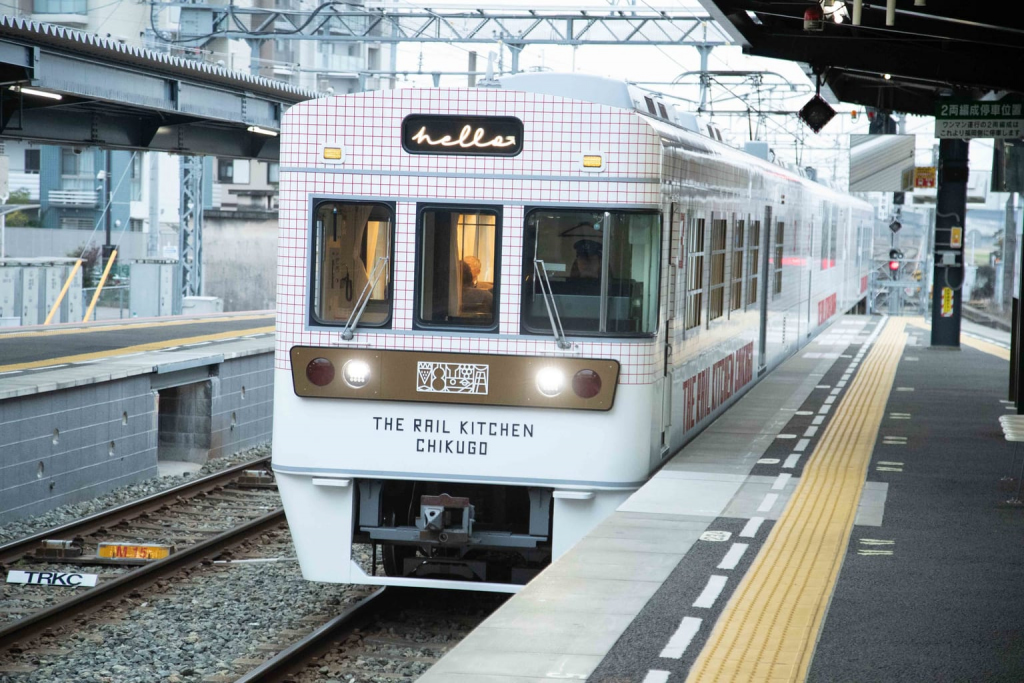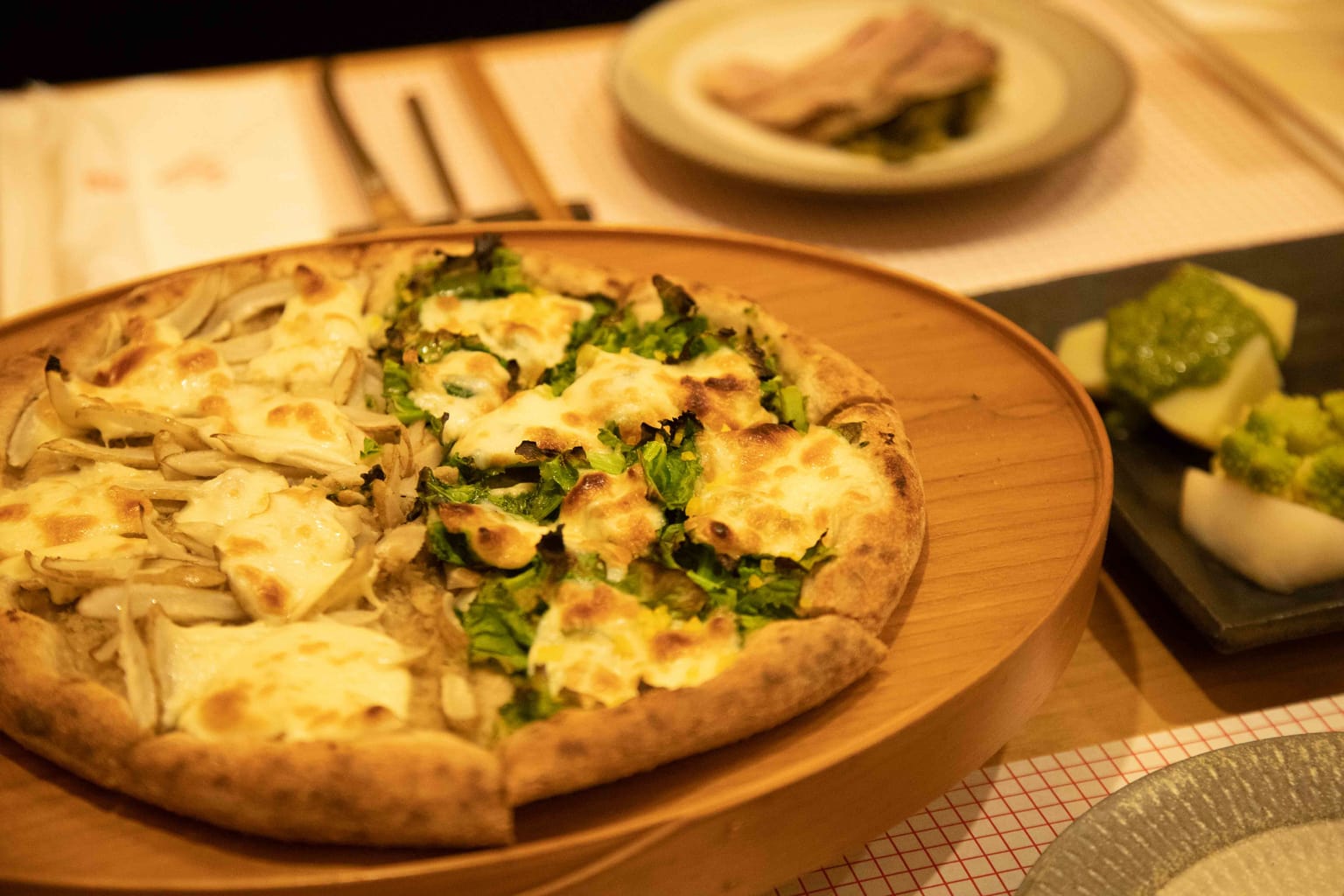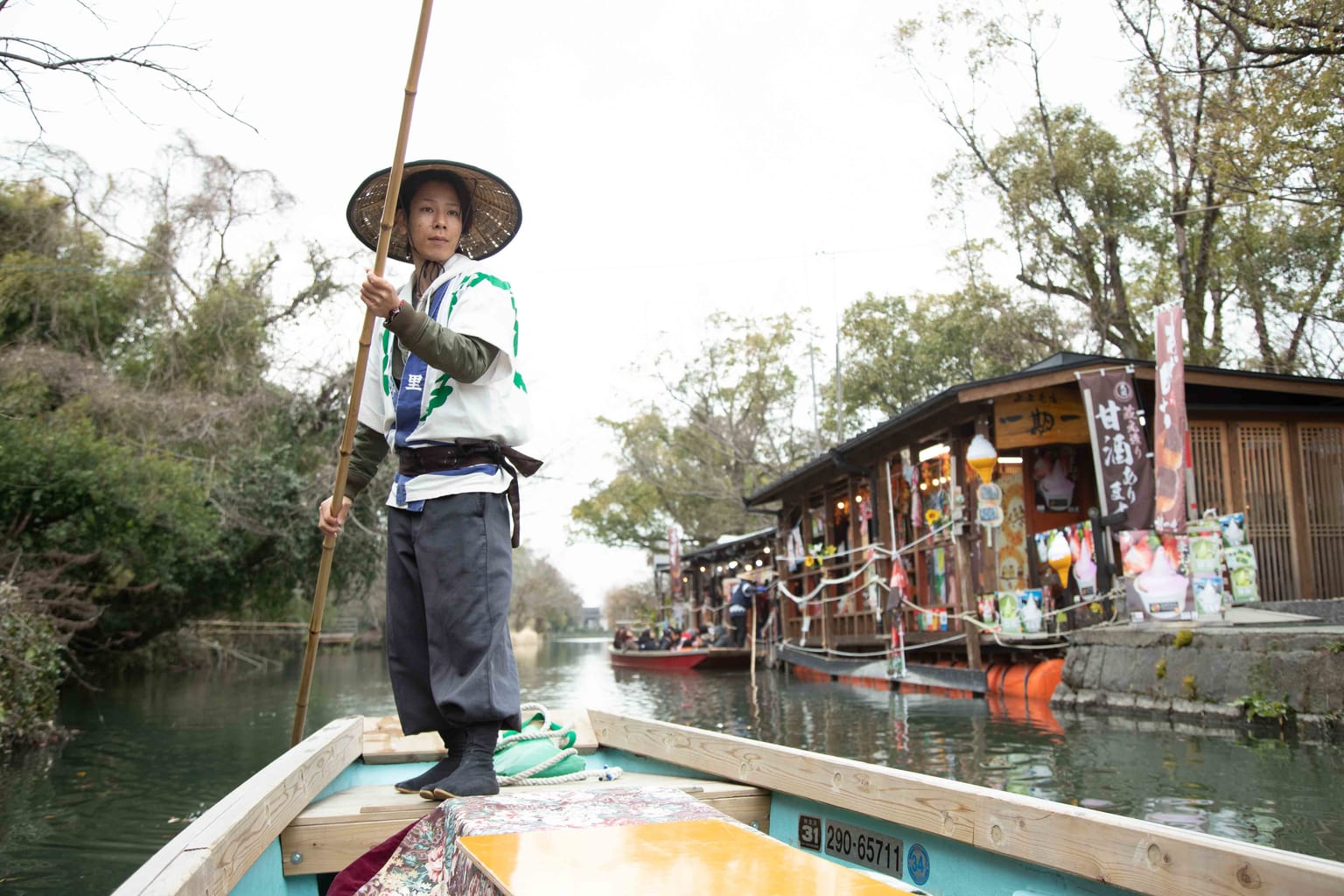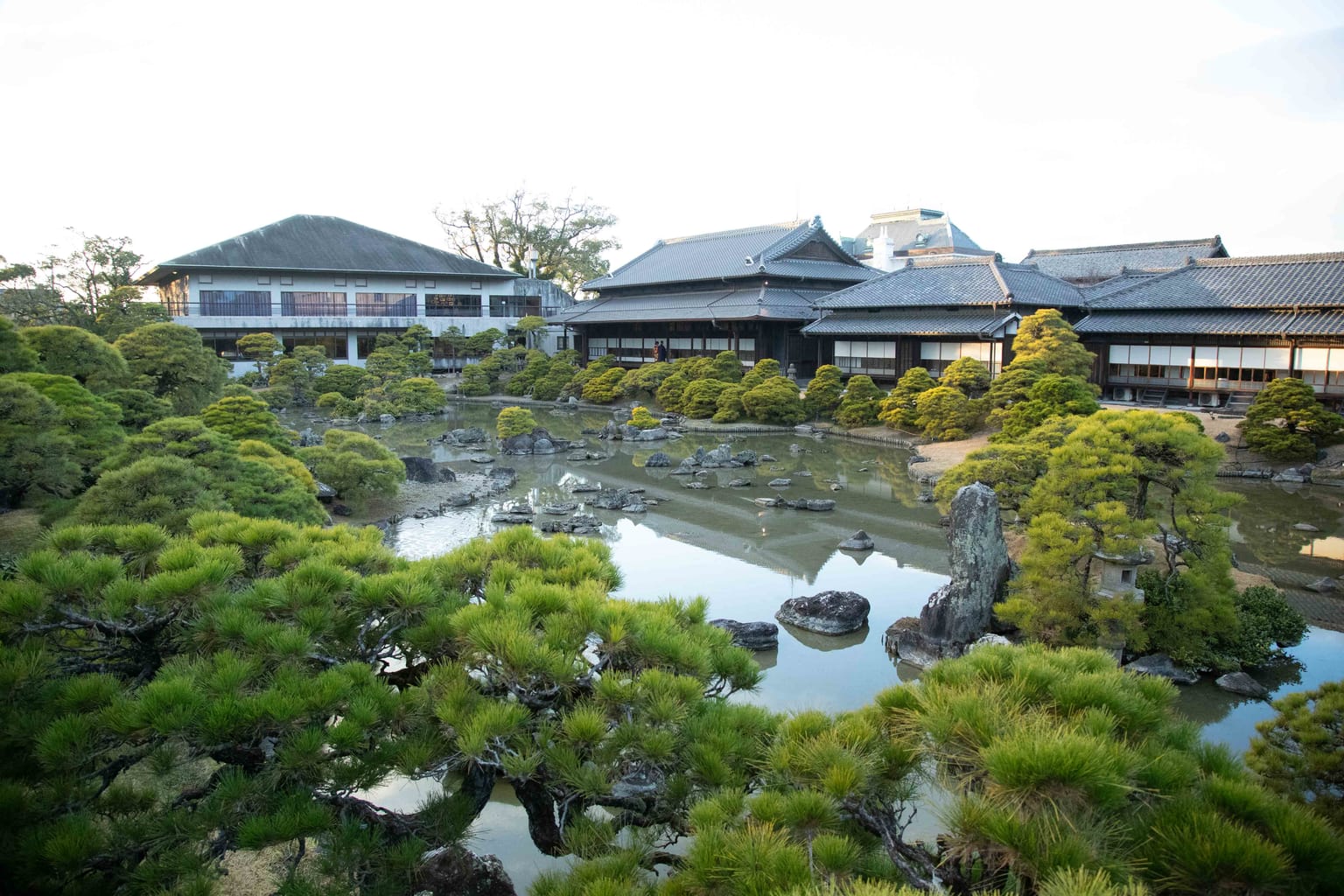It sure had us at “Hello.” Standing on a nondescript platform at Nishitetsu Fukuoka (Tenjin) Station in Fukuoka’s bustling shopping district, a pair of lights resembling round anime eyes grew brighter as the train approached. Instead of its destination, we were greeted by a yellow-light signage in cursive on its front. As the train came to a stop, we caught glimpses of a cozy interior with fully laid tables. Suddenly, the rainy Saturday morning mood lifted. We were about to be let in on one of Fukuoka’s best-kept secrets: The Rail Kitchen Chikugo.
Farm to Train
Launched in March 2019 by Nishi-Nippon Railroad Co. (Nishitetsu), the traveling restaurant plies the Chikugo area, less than an hour south of central Fukuoka. Meticulously curated meals for up to 52 people across three cars are prepared from scratch in its fully equipped kitchen. A built-in kiln churns out handmade pizzas topped with local seasonal vegetables (the burdock and canola flower-topped version changed our minds about meatless pizzas).
“The traveling restaurant plies the Chikugo area, less than an hour south of central Fukuoka”
All ingredients and beverages onboard are locally sourced, said Nishitetsu Assistant Manager Hideho Takada. “We wanted to create something to connect people and let them appreciate the unique produce from local farms along the track,” he explained, as the view outside shifted from generic houses to rolling farmlands. “Pizza made with locally produced flour became our main dish because Fukuoka is the second-largest flour producer in Japan.”
Chikugo Charms
Rail Kitchen’s gourmet offerings are served on modern ceramic and wood-based works by Chikugo’s finest craftsmen. Inside the carriages, Yame bamboo-woven material adorns the ceiling, while rare red-tinted unglazed Jojima tiles and framed pieces of Kurume Kasuri – a dyed textile with a splashed pattern unique to Fukuoka – lend the walls an artistic flair.
The train also offers passengers a chance to stop off and discover the hidden stories of three of Kyushu’s most picturesque historical towns – Dazaifu, Yanagawa and Omuta – depending on their choice of meal. On our agenda was a visit to Dazaifu (40-minute brunch) and Yanagawa (two-hour lunch or dinner).
Studious Spirit
In Dazaifu, we found ourselves merging with a stream of umbrellas bobbing along an approximately 250m-long street that’s filled with souvenir shops and eateries leading up to Dazaifu Tenmangu, one of Japan’s major shrines. Legend has it the shrine was originally built in the 10th century to enshrine a politician, poet and scholar who was deified as a Shinto god of learning. On this Saturday, the place was teeming with students seeking divine assistance for upcoming high-school and university entrance exams.
Flying Tree and Power Spot
The grandeur of Dazaifu Tenmangu was not lost in the crowd, though, as we walked across two beautiful red arch bridges over a landscaped pond toward the honden (main hall). Look out for the tobiume (flying plum tree) on the right, which is said to have taken flight from Kyoto to be reunited with its beloved master.
Behind the honden is a lesser-known spot called Tenkai Inari Shrine. It’s known as the most powerful spot on these grounds for granting wishes, but we found simpler joy by trekking up a winding path paved with vermilion-colored torii gates toward the shrine.
City of Water
About an hour’s train ride farther south from Dazaifu is Yanagawa, where old Japan still lives (and, hopefully, will remain hidden from the kimono-renting crowd). The castle town, which traces its history back to over 400 years ago, is often dubbed the Venice of Japan, thanks to the hundreds of kilometers of waterways – once water moats built as a defense system – that crisscross the town. Today, boatmen use long poles to deftly steer donko bunes (small river boats) along the waterways, taking visitors on scenic kawakudari (downstream) cruises and punctuating the rides with melodious renditions of Yanagawa’s folk songs.
Poetic Heritage
“I’ve been doing this for 17 years,” said our 33-year old boatman. “I have yet to grow sick of it.” It’s not hard to believe. With our legs snug under a kotatsu (table with built-in heater underneath) on the boat, we drifted past postcard streetscapes, complete with traditional warehouses and willow trees that seemed idyllic even in their wintry bareness.
It’s easy to see how this town could have inspired Hakushu Kitahara (1885-1942) to write the tanka (a Japanese poem of 31 syllables), folk songs and children’s songs that cemented him as the founder of modern Japanese poetry. The son of a local sake brewer, he described his hometown as “the mother and creative source” of his poetry. Today, the Yanagawa Municipal Folk Museum stands on a corner of the former Kitahara estate. It was opened in 1985 to honor the poet’s legacy and is definitely worth a visit.
One Ohana Night
Another symbol of Yanagawa is the Ohana, an affectionate local term for the Edo-period residence of the Tachibana clan, feudal lords who once ruled over the town.
Ohana’s rich history of more than four centuries is evident everywhere. It can be traced on the walls of its Meiji-era Western-style Seiyokan (former state guest house), in its museum’s artifacts, and on the 75 gold helmets, once upon a time used in battle, lining its banquet hall (Ohiroma), which is laid with an impressive 100 tatami mats. The colorful sagemon (good luck charms for girls) displays in its former administration room and the Ohana Shoto-en, a stunning Japanese garden dotted with over 200 pine trees, provide a visual feast. Ohana is now a nationally designated scenic spot. It is a popular venue for weddings and operates as a restaurant and an inn. A night’s stay in one of its well-appointed rooms epitomizes the experience of staying at a Japanese ryokan: sublime, subtle and almost surreal.
Sitting in a private tatami room as we wrapped up our day, a seemingly endless stream of delicacies from the Ariake Sea (including the famous Yanagawa steamed and grilled eel dish) filled our table for an exquisite kaiseki dinner (traditional Japanese multicourse cuisine) – many of the ingredients being so unusual that our tastebuds were just becoming acquainted with them for the first time.
From unique cuisine to culturally enriching sightseeing, our Rail Kitchen ride undoubtedly whetted our appetites for many more yet-to-be-discovered stories in our Kyushu journey.
To book your Rail Kitchen Chiguko ride, go to www.railkitchen.jp
How to Get Around Fukuoka
Download My Route, a smartphone app created by Toyota Motor Corp., Nishitetsu and other partners. You can use the app to search for routes (trains, buses and taxis) and find information about shops and events, as well as make payments and reservations.
What to Eat in Dazaifu and Yanagawa
Dazaifu Burger: One of the district’s most famous snacks. Essentially a karaage (Japanese fried chicken) burger accompanied by tartare sauce infused with Fukuoka’s famed plum, it is worth the calories. Find it at Chikushi-An, a local joint about five minutes from Dazaifu Tenmangu.
Unagi no Seiro Mushi: Steamed grilled eel sitting on a bed of rice drenched in a special sweet sauce and sprinkled with thinly sliced egg. An iconic dish in Yanagawa. Get your fix at Koren, located in front of the Nishitetsu-Yanagawa Station. It’s one of the few restaurants that still uses domestic eels.
One More Thing: Yoga in Yanagawa
For an off-the-beaten-path experience in Yanagawa, head to Yoga Shala Aun, a yoga retreat-cum-café that’s less than 15 minutes away by car from Nishitetsu-Yanagawa Station. Doing sun salutations in the Balinese-style studio facing expansive paddy field views bathed in plenty of natural light was a rejuvenating experience. The best part though was getting to meet the infectiously happy Matsufuji family who runs the place.
Photographs by Allan Abani
Sponsored Post












